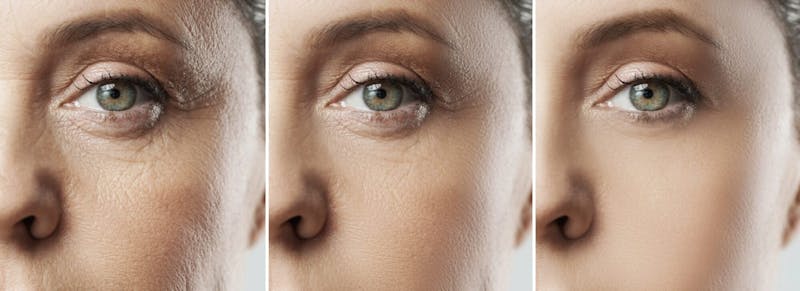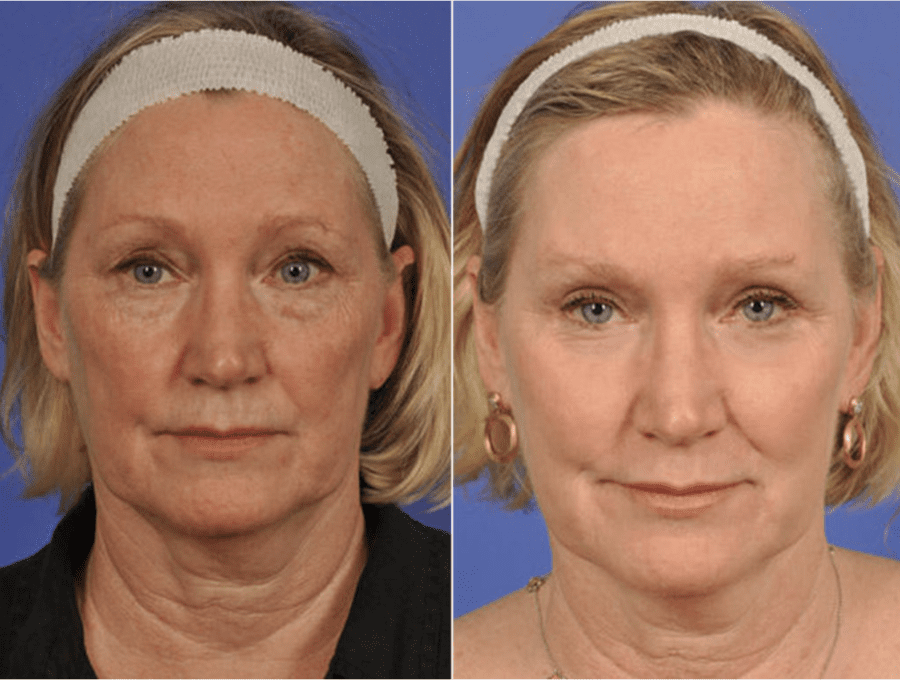
What is laser skin resurfacing?
Laser skin resurfacing is exactly what it sounds like. The light from the laser produces energy. The energy causes disruption of some of the layers of the skin, and the skin is forced to heal. When the skin heals, collagen is generated, collagen reorganizes and builds skin that looks more youthful—that’s tighter and with less age spots and less wrinkles.
Laser is done to treat wrinkles, age spots, sun damage and scars. It is not useful to treat saggy skin, though generalized skin tightening can occur with laser.
There are two types of lasers: nonablative and ablative.
Nonablative lasers
Nonablative lasers don’t injury the skin as substantially—their purpose is only to stimulate collagen production without causing a physical burn from substantial amounts of energy contacting the skin. The results generally that are achieved with nonablative lasers are not as dramatic, and need to be delivered generally with more than a single treatment.
Ablative lasers
Lasers can be delivered both fully ablatively or fractionally. As the name sounds, fractional treatments only treat a fraction of the skin. The laser can be set to treat 8 % of the skin surface, for example, or tuned to treat 25 %, 35 %, etc.
Fractional treatments do not achieve the same benefits as fully ablative laser treatments, but have the advantage of faster healing and shorter downtime.
What are the benefits of laser skin resurfacing?
Depending on the type of skin condition or level of skin damage, we can address a variety of skin challenges and conditions, including:
- Sun damage and age spots
- Fine lines and deep wrinkles
- Skin tone & pigmentation
- Acne and acne scarring
- Enlarged pores, blackheads, and whiteheads
- Unwanted Tattoos
- Rosacea and facial blood vessels
- Post-traumatic scars

60 year-old woman before and after full laser resurfacing. (Note: Upper and lower blepharoplasty also completed.)
Is laser suitable for all types of skin?
Laser resurfacing is generally reserved for patients who have light skin—those who sunburn easily. In general, patients with olive complected or darker skin, generally have to explore other modalities for skin rejuvenation. This is because one of the complications of healing after laser is a change in the pigmentation of the skin. Darker complected patients can develop hyperpigmentation or lose pigment after treatment—neither of these situations are acceptable.
What is it like to undergo a laser resurfacing treatment?
Laser resurfacing is generally performed either in the office or in an operative setting. For fractional laser, topical creams are applied and often supplemented with an injection of a novocain-like substance. Fully ablative lasers in our practice are performed in the operating room. Treatments can be done with or without sedation—we want you to remain completely comfortable through the procedure.
Nonablative lasers that we use routinely include IPL and BBL. We employ C02 fractional laser, a 1927 nm fractional laser, and fully ablative dual erbium laser (Sciton).
Is laser resurfacing painful?
“My friend had a laser resurfacing treatment and said it was the most painful experience of her life, is this true?” Your friend who had that laser who told you that it was the most excruciating experience of their life and that the healing took forever probably had a fully ablative CO2 laser. We don’t do that. It hurts. And the skin has a pearly unnatural sheen afterwards that we feel looks artificial and pasty.
Fractional laser treatments and the fully ablative Scition erbium laser that we use in our practice do not produce this degree of discomfort—unless you consider a mild sunburn to be unpleasant. And they do not produce pasty looking skin.
Are there any risks?
The risks of laser include hyper- and hypo pigmentation. The skin can become lighter or darker than it was before treatment. Hyperpigmentation is completely treatable with topicals and with other lasers which we sometimes employ– and is not a long term issue. Hypo pigmentation has not been a problem with the Sciton laser.
Other complications that are described include infections, particularly viral infections. Pretreatment with antivirals and antibiotics are routine in our practice.
Rarely, scarring from going to deep and applying too much energy to the skin can occur. This is something we uniformly avoid.
What can I expect while healing after my treatment?
After laser treatment, your skin is red and for 24 hours the skin may burn. We cover the skin with emollients that prevent that, and over a 4- to 7-day period, the skin completely regenerates.
Healing generally takes less than a week, but the skin remains red for a time after the procedure. We have multiple modalities to treat the redness. And the cover-ups we show you how to use can begin at around a week.
Who should perform this procedure?
In general, a plastic surgeon, a dermatologist or other specialist who has experience with laser resurfacing may be the best person to do the procedure. Experience is important. Ask your provider about just how experienced they are—this is true for any procedure.
Will I need more than one treatment?
There are specialists who believe a yearly fractional treatment provides rejuvenating and anti-aging benefit, and there are really no clear answers on whether this is fact or fiction. The theory is that instead of looking worse with the passage of years, a yearly treatment will anti-age you yearly.
Fully ablative treatments are reserved for those who have the downtime and who also are willing to have a period of time where their skin is pink. Fractional lasers done on an approximately yearly basis allow the skin to maintain youthfulness without the need to undergo a more invasive procedure.
With fully ablative laser resurfacing treatments, in general, it’s one and done.
What will recovery look like? Is there any downtime?
Downtime with the lasers is completely dependent upon what your underlying skin condition looks like and on your desire for improvement. If you have a lot of wrinkles and require fully ablative laser resurfacing, count on a period of time after the skin regains its epithelium (heals) where the skin will be red. In our practice, we treat the redness 3 to 4 weeks after laser with a red-reducing laser. Nonetheless, the redness can persist, but fades over time. A fractional laser treatment allows for improvement over a much shorter period. After 5 days, you are able to go out with minimal redness, but with continued skin care and solar protection.
How do I take care of my skin after the treatment?
Generally, we use both topical treatments and light-based therapies to expedite healing.
Your skin is more youthful, but also much more sensitive to the environment. You can’t just go out and abuse it– like you might have done decades ago when you took all of this for granted. You will need to protect it from the sun–and to continue anti-aging treatments. We will develop a skin care program for you that will maintain your skin so that your skin—instead of just restarting the clock– continues to improve over time.
Have your patients have good results?
As a cosmetic surgeon, I’ve helped many patients who come to me wanting to fix under-eye bags, crows feet, and fines lines around the mouth. Lasers are an excellent solution either on its own or in combination with a surgical procedure for the best results. The fractionated CO2 laser Lutronic eCO2 laser and Sciton dual erbium laser are two effective lasers that I use at my practice to treat eye wrinkles, festoons (malar bags), improve the texture, pigmentation, and balance of the skin. With any kind of deep penetrating laser, there is a slight increase of downtime, but the results are long-lasting and well worth it. Check out one of my patient’s beautiful results and see for yourself.
Cynthia admits that she’s spent too much time in the sun over the years. She came to W Cosmetic Surgery for laser skin resurfacing. The results are impressive, and take years off her face. Check out her before & after photos and her video testimonial below.
If you’re looking to rejuvenate the skin, you can learn more about getting Laser Skin Resurfacing in Philadelphia on our website. Dr. Allan Wulc is a quadruple board-certified cosmetic and plastic surgeon with over 25 years of experience in eyelid and facial plastic surgery. Laser skin resurfacing is just one of the many talents he specializes in at W Cosmetic Surgery near Philadelphia, PA.
Please call today to ask about laser skin resurfacing. Fill out the form below to schedule a personalized consultation or call (610) 828- 8880.

